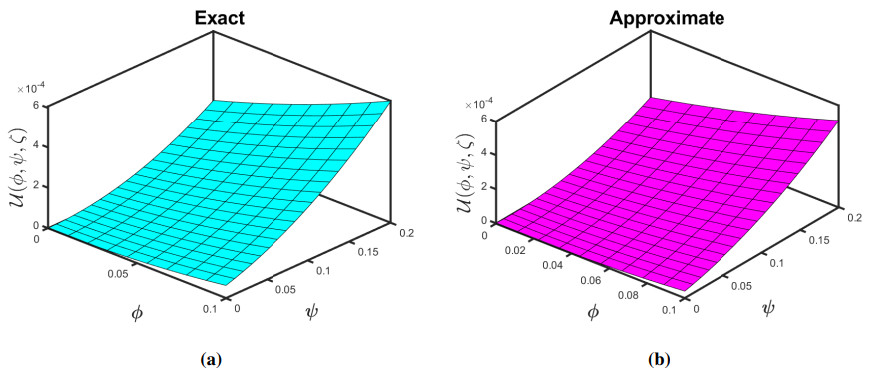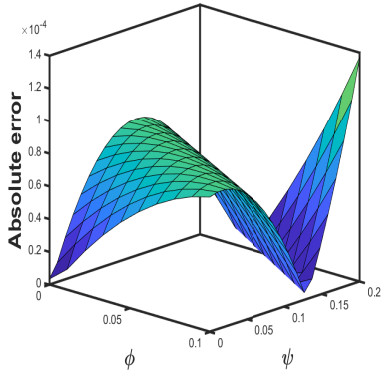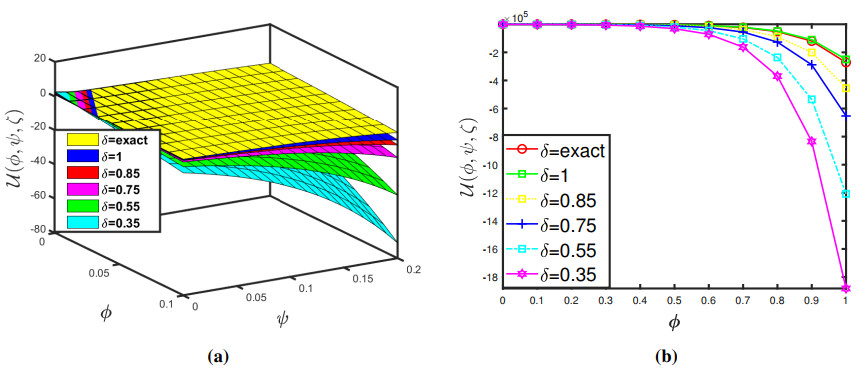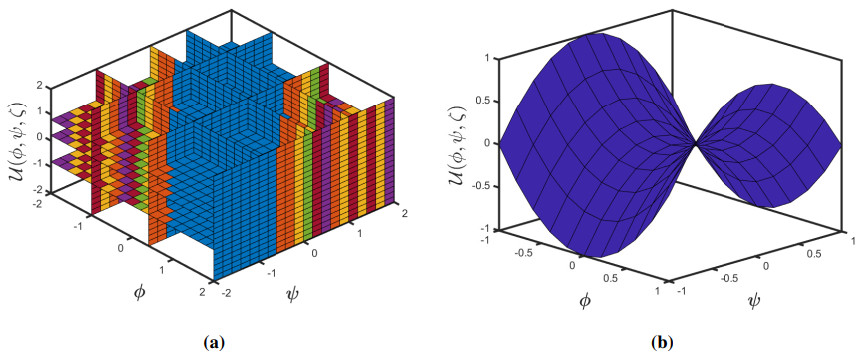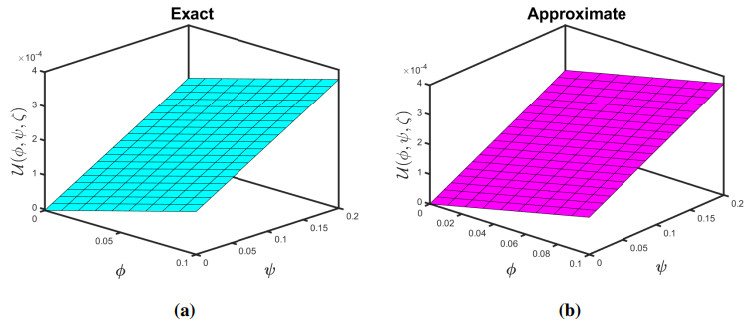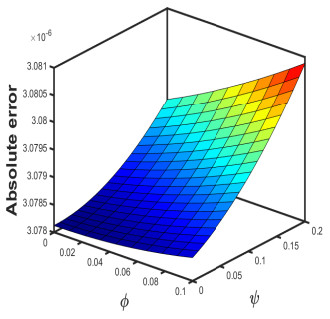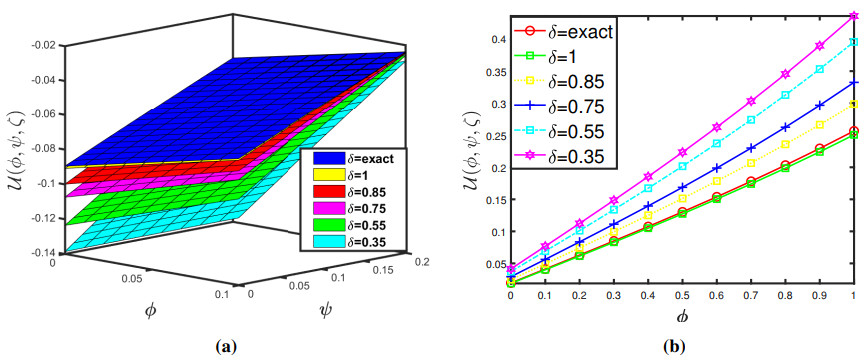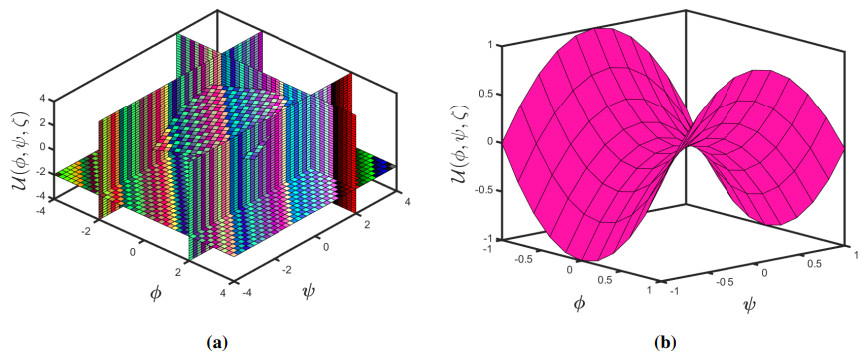1.
Introduction
Fractional partial differential equations (PDEs) have gained prominence and recognition in recent years, owing to their verified applicability in a wide range of relatively diverse domains of science and engineering. For instance, considering the nonlinear oscillation of fractional derivatives can be employed to model earthquakes, fractional derivatives in a fluid-dynamic traffic model can be leveraged to alleviate the deficiency caused by the assumption of a continuous flow of traffic. Researchers including Coimbra, Davison and Essex, Riesz, Riemann and Liouville, Hadamard, Weyl, Jumarie, Caputo and Fabrizio, Atangana and Baleanu, Grünwald and Letnikov, Liouville and Caputo have proposed a variety of fractional operator formulations and conceptions. On the other hand, the Liouville-Caputo is the finest fractional filter. Furthermore, fractional PDEs are used to model a variety of physical phenomena, including chemical reaction and population dynamics, virology, image processing, bifurcation, thermodynamics, Levy statistics, porous media, physics, and engineering problems, (see [1-7]).
The Shehu transform (ST) was recently highlighted by Maitama and Zhao [8] as an interesting integral transformation. A modification of the Laplace and Sumudu transformation is the ST. However, we can retrieve the Laplace transform by replacing ϖ=1 in ST. This approach can be used to compress complex non-linear PDEs into simpler equations.
The Shehu transform (ST) was recently highlighted by Maitama and Zhao [8] as an interesting integral transformation. A modification of the Laplace and Sumudu transformation is the ST. However, we can retrieve the Laplace transform by replacing ϖ=1 in ST. This approach can be used to compress complex non-linear PDEs into simpler equations.
The comprehensive evaluation of numerous advanced asymptotic approaches for the exploration of solitary solutions of nonlinear PDEs, and DEs has been presented, see [9-16]. For instance, the Adomian decomposition method (ADM) [17] for obtaining seven order Sawada-Kotera equations, pseudo-spectral method (PSM) [18] for finding the numerical solution of the Laxs 7th-order KdV equation, q-homotopy analysis method (q-HAM) for finding the convergence of special PDES [19], Lie symmetry analysis (LSA) [20] for dealing with the conservation laws and exact solutions of the seventh-order time fractional Sawada-Kotera-Ito equation, Laguerre wavelets collocation method (LWCM) and Haar wavelet for the numerical solution of the Benjamina-Bona-Mohany equations [21], a new Legendre Wavelets decomposition method (NLWDM) for solving PDEs [22], discrete Adomian decomposition method (DADM) [23] for constructing numerical solution of time fractional Navier-Stokes equation.
The ZKE was built in two dimensions to demonstrate nonlinear complex phenomena such as isotope waves in a massively magnetic flux uncompressed plasma [24,25].The SDM will be implemented to develop the major objectives of this research. The time-fractional ZKE is stated as:
where U=U(ϕ,ψ,ζ) and Dδζ is the Caputo fractional derivative with order δ,0<δ≤1, a1 and b1 are arbitrary constants and ηi,i=1,2,3 are integers and ηi≠0(i=1,2,3) that demonstrates the characteristics of physical phenomena such as ion acoustic waves in a plasma consisting of cold ions and hot isothermal electrons in the framework of a balanced magnetic flux ([26,27]). In [25], for example, the ZKEs were used to investigate shallowly nonlinear isotope ripples in significantly magnetism impaired plasma in three dimensions.
In spite of the incredible improvement, the Adomian decomposition method (ADM) was contemplated by Gorge Adomian in 1980. The ADM, for example, has been effectively defined in numerous analytical structures of PDEs, especially in Burger's equation [28], time-fractional Kawahara equation [29], fuzzy heat-like and wave-like equations [30] and Lane-Emden-Fowler type equations [31]. The ADM was found to be strongly associated with a plethora of integral transforms, including ARA, Shehu, Fourier, Aboodh, Laplace and others. Presently, modified Laplace ADM [32] has been utilized to effectively resolve Volterra integral equations employing the noted numerical formulation, discrete ADM [23] has been used to solve the time-fractional Navier-Stokes equation, and Laplace ADM [33] has been considered to identify the approximate results of a fractional system of epidemic structures of a vector-borne disease, and so on.
Several of the aforesaid approaches have the disadvantage of being always stratified and necessitating a significant amount of algorithmic effort. To minimize the computing complexity and intricacy, we suggested the Shehu decomposition method (SDM), which is a composition of the ST and the decomposition method for solving the time-fractional ZKE, which is the main motivation for this research. The projected technique develops a convergent series as a solution. SDM has fewer parameters than other analytical methods. It is the preferred approach because it does not require discretion or linearization.
In this study, we first provided a fractional ZKE, followed by a description of the SDM, and then, a comparison characterization of the SDM presented with the existing methods. The graphical representations were then thoroughly explained in relation to the ZK problem. We presented an algorithm for SDM, discussed its estimation accuracy, and then showed two examples that demonstrate the effectiveness and stability of a novel approach so that their obtained simulations can be analyzed. Finally, as a part of our concluding remarks, we discussed the accumulated facts of our findings.
2.
Prelude
In order to perform our research, we require various terminologies and postulate outcomes from the literature.
Definition 2.1. ([8]) Shehu transform (ST) for a mapping U(ζ) containing exponential order defined on the set of mappings is described as follows:
where U(ζ) is denoted by S[U(ζ)]=S(ξ,ϖ), is stated as
The following is an example of a supportive ST:
Definition 2.2. ([8]) The inverse ST of a function U(ζ) is described as
Lemma 2.3. Consider ST of U1(ζ) and U2(ζ) are P(ξ,ϖ) and Q(ξ,ϖ), respectively [8],
where γ1 and γ2 are unspecified terms.
Lemma 2.4. ([8])For order δ>0, the Caputo fractional derivative (CFD) of ST is defined as
3.
Description of the SDM
Considering the nonlinear partial differential equation:
subject to the condition
where Dδζ=∂δU(ϕ,ζ)∂ζδ indicates the CFD with 0<δ≤1 while L and ˇN are linear/nonlinear factors and the source term refers to F(ϕ,ζ).
Implementing the ST to (3.1), and we attain
Applying the differentiation property of ST, yields
Th inverse ST of (3.3) provides
The infinite series representation of SDM is denoted by the mapping U(ϕ,ζ) as follows:
Thus, the nonlinearity ˇN(ϕ,ζ) can be estimated by the ADM represented as
where
Substituting (3.5) and (3.6) into (3.4), we have
Consequently, the following is the recursive methodology for (3.7):
4.
Illustrative examples
Example 4.1. Assume the following time-dependent fractional-order Zakharov-Kuznetsov equation:
subject to the initial condition
where θ is an arbitrary constant.
Proof. Applying the ST on both sides of (4.1), we find
Employing the inverse ST, we have
It follows that
Utilizing the Shehu's decomposition method, we get
where ˇN(U) is the Admoian's polynomial describing nonlinear term appearing in the above mentioned equations.
First few Admoian's polynomials are presented as follows:
for ȷ=0,1,2,...
Accordingly, we can derive the remaining terms as follows
The approximate-analytical SDM solution is
The exact solution for δ=1 is presented by
Tables 1 and 2 show the comparison results for exact, SDM, and absolute error of Uabs=‖UE−USDM‖ solution for (4.1), when θ=0001 and for various fractional orders δ=0.67,0.75,1. It can be seen that the proposed method closely corresponds the exact, VIM [34], VIA [35] and RPSM [35].
Taking θ=0.005 and δ=1, we exhibit the approximate-analytical solution of the fractional KZEs equation up to 4 components in Figure 1 (a and b). Furthermore, we establish absolute errors at δ=1 for the exact-approximate solutions in the accompanying Figure 2. Also, we have seen how different fractional orders perform in surface plots and 2D plots in Figure 3 and some δ1δ2−slice (a and b) solutions are presented in 4 when θ=0.005 and ζ=0.5. As a result of this behaviour, we might conclude that the approximation solution tends to be a precise solution. Accordingly, as the iteration increases, the absolute inaccuracy decreases. Consequently, as the number of terms grows, the SDM findings approach the exact result.
The graphs in Figures 1–4 assist us to comprehend the behaviour of fractional orders when space and time scale variables fluctuate. Additionally, the findings of this study will aid scientists connected to pattern formation theory, optical designs, or mathematical modelling in comprehending the structural phenomena of the ANOVA-test. Furthermore, the efficiency of the projected method can be boosted by getting additional approximate solution expressions.
Example 4.2. Assume the following time-dependent fractional-order Zakharov-Kuznetsov equation:
subject to the initial condition
where θ is an arbitrary constant.
Proof. Applying the ST on both sides of (4.12), we find
Employing the inverse ST, we have
It follows that
Utilizing the Shehu's decomposition method, we get
where ˇN(U) is the Admoian's polynomial describing nonlinear term appearing in the above mentioned equations.
First few Admoian's polynomials are presented as follows:
for ȷ=0,1,2,...
Accordingly, we can derive the remaining terms as follows
The approximate-analytical SDM solution is
The exact solution for δ=1 is presented by
Table 3 show the comparison results for exact, SDM, and absolute error of Uabs=‖UE−USDM‖ solution for (4.12), when θ=0001 and for various fractional orders δ=0.67,0.75,1. It can be seen that the proposed method closely matches the exact, and VIM [34].
Taking θ=0.0005 and δ=1, we exhibit the approximate-analytical solution of the fractional KZEs equation up to 4 components in Figure 5 (a and b), respectively. Furthermore, we established absolute errors at different values of δ for the exact-approximate solutions in the accompanying Figure 6. Also, we have seen how different fractional orders perform in 2D and 3D plots in Figure 7 in (a and b) behaves. Also, Figure 8 denotes the δ1δ2-slice solutions for the exact and approximate solutions (a and b), respectively. As a result of this behaviour, we might conclude that the approximation solution tends to actual solution. Accordingly, as iteration increases, the absolute inaccuracy decreases. Consequently, as the iterations expands, the SDM findings approaches the exact result. The graphs in Figures 5–8 assist us to comprehend the behaviour of fractional orders when space and time scale variables fluctuate. Additionally, the findings of this study will aid scientists connecting in pattern formation theory, optical designs, or mathematical modelling in comprehending the structural phenomena of the ANOVA-test. Furthermore, the efficiency of the projected method can be boosted by getting additional approximate solution expressions.
5.
Conclusions
In this paper, the Shehu decomposition method (SDM) is effectively implemented for solving nonlinear time-fractional ZKEs. The proposed findings illustrate that there is a strong correlation between the projected method and the closed form solutions. Moreover, the governed approach is reliable and pragmatic for solving other diverse linear and nonlinear PDEs appearing in various disciplines of physics and mathematics. However, this methodology does not necessitate the condition matrix, Lagrange multiplier, or costly integration calculations, so the findings are noise-free, which addresses the drawbacks of earlier techniques. It is worth mentioning that the proposed methods are pragmatic analytical tools for identifying approximate-analytical solutions to complicated nonlinear PDEs. Moreover, we deduce that this approach will be used to deal with other non-linear fractional order systems of equations that are extremely complex.
Acknowledgments
This research was supported by Taif University Research Supporting Project Number (TURSP-2020/96), Taif University, Taif, Saudi Arabia.
Conflict of interest
The authors declare that they have no conflict of interest.









 DownLoad:
DownLoad:
